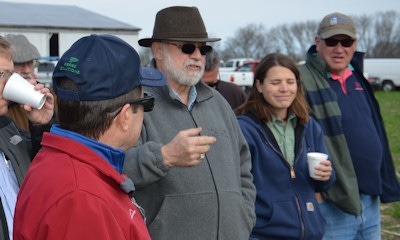
Dressed in a gray coat and a conventional-style hat, with dark glasses and a gray beard, Mark Lawson might not have looked like the person who owned the farm where a recent cover crop field day was held. He didn’t have on a farm cap or a work-type jacket. But don’t let the garb fool you. This man knows farming, knows about hard work, knows the history of how his farm came to be and appreciates it more than most know.

MAN IN THE MIDDLE: Being in the middle of the action isn’t unusual for Mark Lawson (center, in gray coat and hat). He has tried many practices in plots on his farm north of Danville.
Lawson hosted the Hendricks County Soil and Water Conservation District Cover Crop Field Day recently. He seeded cover crop plots on his farm for the first time last fall. But it’s far from the first time he has had plots on the farm. Working in the chemical and seed business, most recently for a long stint with Syngenta, he has had various types of plots on his farm for decades — from a plot trying to attract insects to a plot testing green carpet between corn rows to see how light reflectance would affect corn growth.
If a farmer asked a question, and Lawson didn’t know the answer, he was bent on finding out. Often that meant setting up an experiment on his farm, seeking answers.
Lawson recalls when his dad and uncle cleared out old fences on the farm and made former pastureland, since grown up, more productive. “They went after it one year with crawler tractors and two-bottom plows,” he says. “The fencerows were grown up with blackberry briars. I can still remember seeing one of them start the tractor across the briar patch, get off and let the other one pick it up on the other side of the old fencerow.”
They did more than clear the land, he notes. They did their best to improve conservation measures on the farm, farming across slopes instead of up and down. Lawson has kept up the tradition. A few years ago, he planted 7 acres of vulnerable land to trees. “The drought got part of them, but we’ve still got a good number of trees out there,” he says.
Cover crops are his latest venture. When approached about doing a plot, he didn’t pick the sweetest spot on the farm. He put it on an area where he had grown sweet corn at the edge of other plots for several years. He figured it was in need of improvement, and if cover cops worked like everyone says they did, it would be a good start for improving the soil.
With good stand establishment last fall and good early growth before burndown this spring, he got what he was looking for. Jared Chew, with the local Natural Resources Conservation District, crawled into a hole dug 3 feet deep to check for roots. Even though it was the first year for cover crops, he found plenty, going as deep as 3 feet. That’s what Lawson was looking for.
And if you think sounds tough and up to any task, you should hear about his daughter. She has made a name for herself — as a hunter. Mark has sent out more than one email over the years featuring his daughter with the latest deer she has hunted and killed.
Related: Cover Crops: Best management practices
This Hendricks County landowner may be tough on the outside, but on the inside he has a great love for farming — and now for conservation farming.
About the Author(s)
You May Also Like




